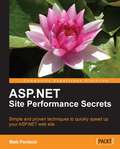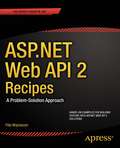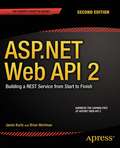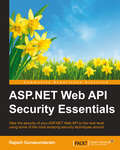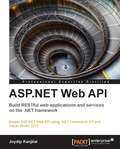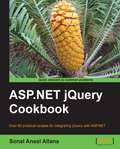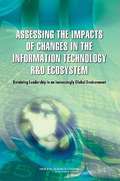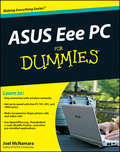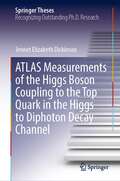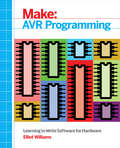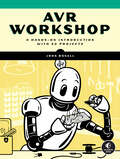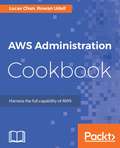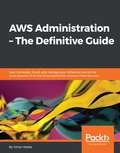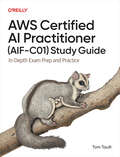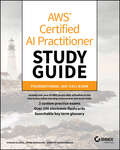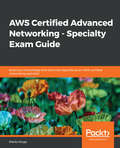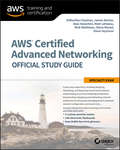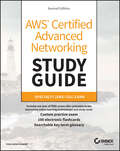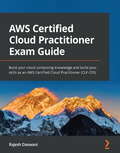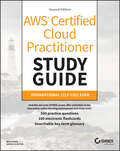- Table View
- List View
ASP.NET Site Performance Secrets
by Matt PerdeckWritten in a practical and clear conversational style, this book is filled with real-life website performance scenarios. It is replete with lots of working code samples and practical advice, and just the right amount of theory you need to make sense of it all. This book is written for ASP.NET/SQL Server-based website developers who want to speed up their site using simple, proven tactics without going through a lot of unnecessary theoretical learning. If your website isn't performing well, this is the ideal book for you.
ASP.NET Web API 2 Recipes: A Problem-Solution Approach
by Filip WojcieszynASP. NET Web API 2 Recipes provides you with the code to solve a full range of Web API problems and question marks that you might face when developing line-of-business applications. ASP. NET Web API 2 Recipes gives you an in-depth explanation for each of these scenarios and shows you how to use Web API with a vast array of . NET application development tools and external libraries, to solve common business problems. Find out how you can build custom web services with ASP. NET Web API more efficiently than ever.
ASP.NET Web API 2: Building A Rest Service From Start To Finish
by Jamie Kurtz Brian WortmanThe ASP. NET MVC Framework has always been a good platform on which to implement REST-based services, but the introduction of the ASP. NET Web API Framework raised the bar to a whole new level. Now in release version 2. 1, the Web API Framework has evolved into a powerful and refreshingly usable platform. This concise book provides technical background and guidance that will enable you to best use the ASP. NET Web API 2 Framework to build world-class REST services. New content in this edition includes: - New capabilities in Web API 2 (currently version 2. 1). - Support for partial updates, or PATCH. - API versioning. - Support for legacy SOAP-based operations. - How to handle non-resource APIs using REST- How to best expose relationships between resources- JSON Web Tokens, CORS, CSRFGet ready for authors Jamie Kurtz and Brian Wortman to take you from zero to REST service hero in no time at all. No prior experience with ASP. NET Web API is required; all Web API-related concepts are introduced from basic principles and developed to the point where you can use them in a production system. A good working knowledge of C# and the . NET Framework are the only prerequisites to best benefit from this book.
ASP.NET Web API Security Essentials
by Rajesh GunasundaramThis book is intended for anyone who has previous knowledge of developing ASP.NET Web API applications. Good working knowledge and experience with C# and.NET Framework are prerequisites for this book.
ASP.NET Web API: Build RESTful web applications and services on the .NET framework
by Joydip KanjilalThis book is a step-by-step, practical tutorial with a simple approach to help you build RESTful web applications and services on the .NET framework quickly and efficiently.This book is for ASP.NET web developers who want to explore REST-based services with C# 5. This book contains many real-world code examples with explanations whenever necessary. Some experience with C# and ASP.NET 4 is expected.
ASP.NET in a Nutshell, 2nd Edition
by G. Andrew Duthie Matthew MacdonaldASP.NET in a Nutshell is a concise, one-volume reference to everything you need to make effective use of ASP.NET. An invaluable resource that goes beyond the published documentation to highlight little-known details, stress practical uses for particular features, and provide real-world examples that show how features can be used in a working application, ASP.NET in a Nutshell is the definitive guide for developers of both applications and web services. Updated for Visual Studio .NET 2003, the 2nd edition of this book includes fresh information on application and web service development, custom controls, data access, security, deployment, and error handling, new material on web application development for mobile devices, plus an overview of the class libraries. For developers who still use Microsoft's older ASP technology, this book also provides information for migrating to ASP.NET. The material in ASP.NET in a Nutshell is presented in three sections: A fast-paced introduction to ASP.NET that examines topics such as building ASP.NET applications, developing web services, creating custom controls and user controls for maximum code reuse, debugging and handling errors, understanding ASP.NET security, and configuring and deploying an ASP.NET application A detailed reference to the properties, methods, and events of the most frequently used ASP.NET classes which include the Page class and the new .NET classes, such as HttpApplicationState and HttpSessionState, which correspond to the intrinsic objects in classic ASP. Configuration settings in web.config are also documented A Quick Reference to the types (the classes, structures, interfaces, delegates, events, and enumerations) found in web-related namespaces to the .NET Framework Class Library. Like other books in the "In a Nutshell" series, ASP.NET in a Nutshell , 2nd Edition, offers the facts, including critical background information, in a no-nonsense manner that users will refer to again and again. With its wealth of up-to-date information, ASP.NET in a Nutshell is a book that web developers will refer to again and again.
ASP.NET jQuery Cookbook
by Sonal Aneel AllanaWritten in a cookbook style, this book offers solutions using a recipe-based approach. Each recipe contains step-by-step instructions followed by an analysis of what was done in each task and other useful information. The cookbook approach means you can dive into whatever recipes you want in no particular order. This book is for ASP.NET developers who want to learn ASP.NET and jQuery integration. The book assumes you have prior experience of developing web applications using ASP.NET, C#, Visual Studio, and jQuery. As this book targets readers of various experience levels, you will find useful recipes regardless of your skill level.
ASP.NET jQuery Cookbook - Second Edition
by Sonal Aneel AllanaOver 60 recipes for writing client script in ASP.NET 4.6 applications using jQuery About This Book * This is a step-by-step guide to solve common problems in ASP.NET applications * Easy-to-follow recipes to write client scripts effortlessly and quickly * A hands-on approach that will show you how to interface jQuery with ASP.NET websites and MVC Who This Book Is For This book is for ASP.NET developers who want to use jQuery to write client scripts for cross-browser compatibility. The book assumes no prior knowledge of ASP.NET or jQuery, and every recipe is self-contained and explained in an easy-to-follow manner. Familiarity with Visual Studio and MS SQL Server is preferred, but not compulsory. What You Will Learn * Download and include jQuery in ASP.NET websites and MVC * Use jQuery selectors with ASP.NET server controls * Get to know about event handling and DOM traversal * Deploy jQuery for visual effects and animations * Develop AJAX-enabled ASP.NET applications * Create your own plugins * Solve common problems using less code and cut down your development time In Detail jQuery is a lightweight JavaScript library that has changed the landscape of client scripting in web applications. Developed by John Resig in 2006, it has taken the web by storm because of its cross-browser compatibility and the ability to get more done with less code. It has gained popularity with ASP.NET developers and is now distributed with Visual Studio and the NuGet package manager. ASP.NET jQuery Cookbook explores the wide range of utilities that the jQuery library provides. It teaches you the nitty-gritty of plugging in these features in ASP.NET web applications. It covers every aspect of interfacing the library, right from downloading and including jQuery on web pages to selecting controls, handling events, and creating animations. This book also walks you through DOM traversal and manipulation in ASP.NET and then through visual effects and graphics in ASP.NET sites. It explores advanced features such as posting AJAX requests and writing plugins. It will provide you with all the information you need to use this library confidently with ASP.NET. Style and approach This book takes a hands-on, pragmatic approach to solving common problems in ASP.NET applications using jQuery. Every recipe has detailed steps with screen captures and code snippets. The necessary theoretical concepts are introduced as and when needed.
ASSESSING THE IMPACTS OF CHANGES IN THE INFORMATION TECHNOLOGY R&D ECOSYSTEM: Retaining Leadership in an Increasingly Global Environment
by National Research Council of the National AcademiesThe U.S. information technology (IT) research and development (R&D) ecosystem was the envy of the world in 1995. However, this position of leadership is not a birthright, and it is now under pressure. In recent years, the rapid globalization of markets, labor pools, and capital flows have encouraged many strong national competitors. During the same period, national policies have not sufficiently buttressed the ecosystem, or have generated side effects that have reduced its effectiveness. As a result, the U.S. position in IT leadership today has materially eroded compared with that of prior decades, and the nation risks ceding IT leadership to other nations within a generation. Assessing the Impacts of Changes in the Information Technology R&D Ecosystem calls for a recommitment to providing the resources needed to fuel U.S. IT innovation, to removing important roadblocks that reduce the ecosystem's effectiveness in generating innovation and the fruits of innovation, and to becoming a lead innovator and user of IT. The book examines these issues and makes recommendations to strengthen the U.S. IT R&D ecosystem.
ASUS Eee PC For Dummies
by Joel McnamaraWhat can you do with your Eee PC? Find out how to get the most from this mini-laptop with Asus Eee PC For Dummies. It shows you how to get things done--using the Linux operating system and applications, navigating the tabbed desktop, adding hardware and software, backing up and restoring the Eee PC, and more.You'll learn how to set up Windows, take advantage of all the pre-installed software, ensure that your computer is secure, and even run your Eee PC on solar power. You'll find tips for configuring printers and changing touchpad settings, techniques for making Skype phone calls and listening to Internet radio, and advice for adding storage and peripherals. It also helps you:Take full advantage of this exciting, ultra-portable "netbook" PCSet up your wireless connectionMake free Skype phone calls and video callsUse OpenOffice.org, Thunderbird e-mail, Mozilla Firefox, and other included applicationsUse the versatile OpenOffice productivity suite, including Writer for word processing, Calc for spreadsheets, and Impress for presentationsCompare the advantages of Windows vs. LinuxDiscover the science, language, math, and art functions that kids can enjoy on the EeeEnjoy built-in games, watch videos, play music, organize and view photos, and moreBoost storage and memory with SD cards and USB drives, go Bluetooth, and add a GPSGet the scoop on backups, explore the advanced desktop, and customize the user interfaceThe Eee PC makes it simple to surf the Web, play games, work, and more. Asus Eee PC For Dummies makes it easier!
ATLAS Measurements of the Higgs Boson Coupling to the Top Quark in the Higgs to Diphoton Decay Channel (Springer Theses)
by Jennet Elizabeth DickinsonDuring Run 2 of the Large Hadron Collider, the ATLAS experiment recorded proton-proton collision events at 13 TeV, the highest energy ever achieved in a collider. Analysis of this dataset has provided new opportunities for precision measurements of the Higgs boson, including its interaction with the top quark. The Higgs-top coupling can be directly probed through the production of a Higgs boson in association with a top-antitop quark pair (ttH). The Higgs to diphoton decay channel is among the most sensitive for ttH measurements due to the excellent diphoton mass resolution of the ATLAS detector and the clean signature of this decay. Event selection criteria were developed using novel Machine Learning techniques to target ttH events, yielding a precise measurement of the ttH cross section in the diphoton channel and a 6.3 $\sigma$ observation of the ttH process in combination with other decay channels, as well as stringent limits on CP violation in the Higgs-top coupling.
AVR Programming: Learning to Write Software for Hardware
by Elliot WilliamsAtmel's AVR microcontrollers are the chips that power Arduino, and are the go-to chip for many hobbyist and hardware hacking projects. In this book you'll set aside the layers of abstraction provided by the Arduino environment and learn how to program AVR microcontrollers directly. In doing so, you'll get closer to the chip and you'll be able to squeeze more power and features out of it.Each chapter of this book is centered around projects that incorporate that particular microcontroller topic. Each project includes schematics, code, and illustrations of a working project. Program a range of AVR chipsExtend and re-use other people’s code and circuitsInterface with USB, I2C, and SPI peripheral devicesLearn to access the full range of power and speed of the microcontrollerBuild projects including Cylon Eyes, a Square-Wave Organ, an AM Radio, a Passive Light-Sensor Alarm, Temperature Logger, and moreUnderstand what's happening behind the scenes even when using the Arduino IDE
AVR Workshop: A Hands-On Introduction with 60 Projects
by John BoxallBuild more than 55 hands-on, wide-ranging projects with the popular and versatile AVR family of microcontrollers.AVR Workshop is a comprehensive introduction to working with the Microchip AVR 8-bit family of microcontrollers – made famous through their use in Arduino and other compatible boards. Whether you&’re an absolute beginner or longtime electronics enthusiast, this book gives you the latest coding and hardware knowledge required to build over 55 projects. After the author guides you through the basic C programming skills you need to work directly with ATmega328P-PU and ATtiny85 microcontrollers, your operation will be up and running. You&’ll go from building blinking LEDs and handling various types of user input, to creating real-time clocks, digital thermometers, and even controlling small motorized devices.
AWS Administration - The Definitive Guide: Design, build, and manage your infrastructure on Amazon Web Services, 2nd Edition
by Yohan WadiaLeverage this step-by-step guide to build a highly secure, fault-tolerant, and scalable Cloud environment Key FeaturesLearn how to leverage various Amazon Web Services (AWS) components and services to build a secure, reliable, and robust environment to host your applications on.Delve into core AWS service offerings with hands-on tutorials, real-world use case scenarios, and best practices.A self-paced, systematic, and step-by-step guide to learning and implementing AWS in your own environment.Book DescriptionMany businesses are moving from traditional data centers to AWS because of its reliability, vast service offerings, lower costs, and high rate of innovation. AWS can be used to accomplish a variety of both simple and tedious tasks. Whether you are a seasoned system admin or a rookie, this book will help you to learn all the skills you need to work with the AWS cloud.This book guides you through some of the most popular AWS services, such as EC2, Elastic Beanstalk, EFS, CloudTrail, Redshift, EMR, Data Pipeline, and IoT using a simple, real-world, application-hosting example. This book will also enhance your application delivery skills with the latest AWS services, such as CodeCommit, CodeDeploy, and CodePipeline, to provide continuous delivery and deployment, while also securing and monitoring your environment's workflow. Each chapter is designed to provide you with maximal information about each AWS service, coupled with easy to follow, hands-on steps, best practices, tips, and recommendations.By the end of the book, you will be able to create a highly secure, fault-tolerant, and scalable environment for your applications to run on.What you will learn Take an in-depth look at what's new with AWS, along with how to effectively manage and automate your EC2 infrastructure with AWS Systems Manager Deploy and scale your applications with ease using AWS Elastic Beanstalk and Amazon Elastic File System Secure and govern your environments using AWS CloudTrail, AWS Config, and AWS Shield Learn the DevOps way using a combination of AWS CodeCommit, AWS CodeDeploy, and AWSCodePipeline Run big data analytics and workloads using Amazon EMR and Amazon Redshift Learn to back up and safeguard your data using AWS Data Pipeline Get started with the Internet of Things using AWS IoT and AWS GreengrassWho this book is forThis book is for those who want to learn and leverage the rich plethora of services provided by AWS. Although no prior experience with AWS is required, it is recommended that you have some hands-on experience of Linux, Web Services, and basic networking.
AWS Administration Cookbook
by Lucas Chan Rowan UdellBuild, automate, and manage your AWS-based cloud environments About This Book • Install, configure, and administer computing, storage, and networking in the AWS cloud • Automate your infrastructure and control every aspect of it through infrastructure as code • Work through exciting recipes to administer your AWS cloud Who This Book Is For If you are an administrator, DevOps engineer, or an IT professional who is moving to an AWS-based cloud environment, then this book is for you. It assumes familiarity with cloud computing platforms, and that you have some understanding of virtualization, networking, and other administration-related tasks. What You Will Learn • Discover the best practices to achieve an automated repeatable infrastructure in AWS • Bring down your IT costs by managing AWS successfully and deliver high availability, fault tolerance, and scalability • Make any website faster with static and dynamic caching • Create monitoring and alerting dashboards using CloudWatch • Migrate a database to AWS • Set up consolidated billing to achieve simple and effective cost management with accounts • Host a domain and find out how you can automate health checks In Detail Amazon Web Services (AWS) is a bundled remote computing service that provides cloud computing infrastructure over the Internet with storage, bandwidth, and customized support for application programming interfaces (API). Implementing these services to efficiently administer your cloud environments is a core task. This book will help you build and administer your cloud environment with AWS. We'll begin with the AWS fundamentals, and you'll build the foundation for the recipes you'll work on throughout the book. Next, you will find out how to manage multiple accounts and set up consolidated billing. You will then learn to set up reliable and fast hosting for static websites, share data between running instances, and back up your data for compliance. Moving on, you will find out how to use the compute service to enable consistent and fast instance provisioning, and will see how to provision storage volumes and autoscale an application server. Next, you'll discover how to effectively use the networking and database service of AWS. You will also learn about the different management tools of AWS along with securing your AWS cloud. Finally, you will learn to estimate the costs for your cloud. By the end of the book, you will be able to easily administer your AWS cloud. Style and approach This practical guide is packed with clear, practical, instruction-based recipes that will enable you to use and implement the latest features of AWS.
AWS Administration – The Definitive Guide
by Yohan WadiaLearn to design, build, and manage your infrastructure on the most popular of all the Cloud platforms--Amazon Web Services About This Book * Learn how to leverage various Amazon Web Services (AWS) components and services to build a secure, reliable, and robust environment to host your applications on * Deep dive into the core AWS service offerings with hands-on tutorials, real-world use case scenarios, and best practices * A self-paced, systematic, and step-by-step guide to learning and implementing AWS in your own environment Who This Book Is For This book is for those who want to learn and leverage AWS. Although no prior experience with AWS is required, it is recommended that you have some hands-on experience of Linux, Web Services, and basic networking What You Will Learn * A brief introduction to Cloud Computing and AWS accompanied by steps to sign up for your first AWS account * Create and manage users, groups, and permissions using AWSS Identity and Access Management services * Get started with deploying and accessing EC2 instances, working with EBS Volumes and Snapshots * Customize and create your very own Amazon Machine Image * Design and deploy your instances on a highly secured, network isolated environment using Amazon VPC * Effectively monitor your AWS environment using specialized alarms, custom monitoring metrics, and much more * Explore the various benefits of Database-as-a-Service offerings and leverage them using Amazon RDS and Amazon DynamoDB * Take an in-depth look at what's new with AWS, including EC2 Container Service and Elastic File System In Detail AWS is at the forefront of Cloud Computing today. Many businesses are moving away from traditional datacenters and toward AWS because of its reliability, vast service offerings, lower costs, and high rate of innovation. Because of its versatility and flexible design, AWS can be used to accomplish a variety of simple and complicated tasks such as hosting multitier websites, running large scale parallel processing, content delivery, petabyte storage and archival, and lots more. Whether you are a seasoned sysadmin or a rookie, this book will provide you with all the necessary skills to design, deploy, and manage your applications on the AWS cloud platform. The book guides you through the core AWS services such as IAM, EC2, VPC, RDS, and S3 using a simple real world application hosting example that you can relate to. Each chapter is designed to provide you with the most information possible about a particular AWS service coupled with easy to follow hands-on steps, best practices, tips, and recommendations. By the end of the book, you will be able to create a highly secure, fault tolerant, and scalable environment for your applications to run on. Style and approach This in-depth and insightful guide is filled with easy-to-follow examples, real-world use cases, best practices, and recommendations that will help you design and leverage AWS.
AWS Automation Cookbook
by Nikit SwarajAutomate release processes, deployment, and continuous integration of your application as well as infrastructure automation with the powerful services offered by AWS About This Book • Accelerate your infrastructure's productivity by implementing a continuous delivery pipeline within your environment • Leverage AWS services and Jenkins 2.0 to perform complete application deployments on Linux servers • This recipe-based guide that will help you minimize application deployment downtime Who This Book Is For This book is for developers and system administrators who are responsible for hosting their application and managing instances in AWS. It's also ideal for DevOps engineers looking to provide continuous integration, deployment, and delivery. A basic understanding of AWS, Jenkins, and some scripting knowledge is needed. What You Will Learn • Build a sample Maven and NodeJS Application using CodeBuild • Deploy the application in EC2/Auto Scaling and see how CodePipeline helps you integrate AWS services • Build a highly scalable and fault tolerant CI/CD pipeline • Achieve the CI/CD of a microservice architecture application in AWS ECS using CodePipeline, CodeBuild, ECR, and CloudFormation • Automate the provisioning of your infrastructure using CloudFormation and Ansible • Automate daily tasks and audit compliance using AWS Lambda • Deploy microservices applications on Kubernetes using Jenkins Pipeline 2.0 In Detail AWS CodeDeploy, AWS CodeBuild, and CodePipeline are scalable services offered by AWS that automate an application's build and deployment pipeline. In order to deliver tremendous speed and agility, every organization is moving toward automating an entire application pipeline. This book will cover all the AWS services required to automate your deployment to your instances. You'll begin by setting up and using one of the AWS services for automation – CodeCommit. Next, you'll learn how to build a sample Maven and NodeJS Application using CodeBuild. After you've built the application, you'll see how to use CodeDeploy to deploy the application in EC2/Autoscaling. You'll also build a highly scalable and fault tolerant continuous integration (CI)/continuous deployment (CD) pipeline using some easy-to-follow recipes. Following this, you'll achieve CI/CD for Microservices application and reduce the risk within your software development lifecycle. You'll also learn to set up an infrastructure using CloudFormation Template and Ansible, and see how to automate AWS resources using AWS Lambda. Finally, you'll learn to automate instances in AWS and automate the deployment lifecycle of applications.By the end of this book, you'll be able to minimize application downtime and implement CI/CD, gaining total control over your software development lifecycle. Style and approach This book takes a "How to do it" approach, providing with easy solutions to automate common maintenance and deployment tasks.
AWS Certified AI Practitioner (AIF-C01) Study Guide: In-Depth Exam Prep and Practice
by Tom TaulliAI is transforming industries, and cloud-based AI expertise is in high demand. This study guide is your essential resource for mastering foundational AI concepts and AWS tools while preparing for the AIF-C01 certification exam. Author Tom Taulli breaks down complex topics into practical, easy-to-understand lessons that will enhance the test-readiness of IT professionals, developers, or data analysts looking to expand into AI. Covering key areas like machine learning, natural language processing, computer vision, and generative AI, this guide also provides hands-on experience with AWS tools such as SageMaker, Bedrock, Rekognition, and Comprehend. With real-world examples, ethical considerations, and exam-focused strategies, you'll gain the confidence to both pass the exam and apply AI concepts in your career. Understand core AI principles and their applications in AWS Learn how to use AWS's AI tools for real-world business solutions Grasp key exam strategies with practice questions and expert insights Apply AI techniques confidently in cloud environments Achieve certification and enhance your career in AI and cloud computing
AWS Certified AI Practitioner Study Guide: Foundational (AIF-C01) Exam (Sybex Study Guide)
by Shreyas Subramanian Vikram Elango Vivek GangasaniQuickly and intelligently prepare for the AIF-C01 exam and succeed in your first role as an AWS AI practitioner In AWS Certified AI Practitioner Study Guide: Foundational (AIF-C01) Exam, a team of veteran AWS and AI specialists walks you through an efficient and effective path to success on the challenging AIF-C01 exam. You'll demonstrate your knowledge and effectiveness with artificial intelligence (AI) and machine learning (ML), generative AI technologies, and their associated AWS services and tools, independent of any specific job role or industry title. You'll discover how to understand the appropriate uses of AI, ML, and generative AI technologies, when to use the various products and tools available, and how to ask relevant questions within your organization. The book covers the fundamentals of AI, ML, and generative AI, applications of foundation models, guidelines for responsible AI use, and security, compliance, and governance for AI solutions. Inside the book: Complimentary access to the online Sybex learning environment, including practice tests and exams, chapter review questions, flashcards, and a searchable key term glossary Material to help you become familiar with Amazon Web Services tools, including EC2, S3, Lambda, and SageMaker Explanations of Amazon Web Services infrastructure, including discussions of AWS regions, availability zones, and edge locations Perfect for anyone interested in building AI/ML solutions on Amazon Web Services, AWS Certified AI Practitioner Study Guide is a must-read resource for everyone planning to take the AIF-C01 exam, as well as those interested in working—or already working—in this dynamic and exciting field.
AWS Certified Advanced Networking - Specialty Exam Guide: Build your knowledge and technical expertise as an AWS-certified networking specialist
by Marko SlugaDevelop technical skills and expertise to automate AWS networking tasksKey FeaturesA fast paced guide that will help you pass the exam with confidenceLearn advanced skill sets to build effective AWS networking solutions Enhance your AWS skills with practice exercises and mock testsBook DescriptionAmazon has recently come up a with specialty certifications which validates a particular user's expertise that he/she would want to build a career in. Since the Cloud market now demands of AWS networking skills this becomes the most wanted certification to upheld ones industry portfolio. This book would be your ideal companion to getting skilled with complex and creative networking solutions. Cloud practitioners or associate-level certified individuals interested in validating advanced skills in networking can opt for this practical guide.This book will include topics that will help you design and implement AWS and hybrid IT network architectures along with some network automation tasks. You will also delve deep into topics that will help you design and maintain network architecture for all AWS services. Like most of our certification guides this book will also follow a unique approach of testing your learning with chapter-level practice exercises and certification-based mock tests. The exam mock tests will help you gauge whether you are ready to take the certification exam or not. This book will also be an advanced guide for networking professionals to enhance their networking skills and get certified. By the end of this book, you will be all equipped with AWS networking concepts and techniques and will have mastered core architectural best practices.What you will learnFormulate solution plans and provide guidance on AWS architecture best practicesDesign and deploy scalable, highly available, and fault-tolerant systems on AWSIdentify the tools required to replicate an on-premises network in AWSAnalyze the access and egress of data to and from AWSSelect the appropriate AWS service based on data, compute, database, or security requirementsEstimate AWS costs and identify cost control mechanismsWho this book is forIf you are a system administrator, or a network engineer interested in getting certified with an advanced Cloud networking certification then this book is for you. Prior experience in Cloud administration and networking would be necessary.
AWS Certified Advanced Networking Official Study Guide: Specialty Exam
by Sidhartha Chauhan James Devine Alan Halachmi Matt Lehwess Nick Matthews Steve Morad Steve SeymourThe official study guide for the AWS certification specialty exam The AWS Certified Advanced Networking Official Study Guide – Specialty Exam helps to ensure your preparation for the AWS Certified Advanced Networking – Specialty Exam. Expert review of AWS fundamentals align with the exam objectives, and detailed explanations of key exam topics merge with real-world scenarios to help you build the robust knowledge base you need to succeed on the exam—and in the field as an AWS Certified Networking specialist. Coverage includes the design, implementation, and deployment of cloud-based solutions; core AWS services implementation and knowledge of architectural best practices; AWS service architecture design and maintenance; networking automation; and more. You also get one year of free access to Sybex’s online interactive learning environment and study tools, which features flashcards, a glossary, chapter tests, practice exams, and a test bank to help you track your progress and gauge your readiness as exam day grows near. The AWS credential validates your skills surrounding AWS and hybrid IT network architectures at scale. The exam assumes existing competency with advanced networking tasks, and assesses your ability to apply deep technical knowledge to the design and implementation of AWS services. This book provides comprehensive review and extensive opportunities for practice, so you can polish your skills and approach exam day with confidence. Study key exam essentials with expert insight Understand how AWS skills translate to real-world solutions Test your knowledge with challenging review questions Access online study tools, chapter tests, practice exams, and more Technical expertise in cloud computing, using AWS, is in high demand, and the AWS certification shows employers that you have the knowledge and skills needed to deliver practical, forward-looking cloud-based solutions. The AWS Certified Advanced Networking Official Study Guide – Specialty Exam helps you learn what you need to take this next big step for your career.
AWS Certified Advanced Networking Study Guide: Specialty (ANS-C01) Exam
by Todd MontgomeryThe latest edition of the official study guide for the AWS Advanced Networking certification specialty exam The newly revised second edition of the AWS Certified Advanced Networking Study Guide: Specialty (ANS-C01) Exam delivers an expert review of Amazon Web Services Networking fundamentals as they relate to the ANS-C01 exam. You’ll find detailed explanations of critical exam topics combined with real-world scenarios that will help you build the robust knowledge base you need for the test—and to succeed in the field as an AWS Certified Networking specialist. Learn about the design, implementation and deployment of AWS cloud-based Networking solutions, core services implementation, AWS service architecture design and maintenance (including architectural best practices), monitoring, Hybrid networks, security, compliance, governance, and network automation. The book also offers one year of free access to Sybex’s online interactive learning environment and expert study tools, featuring flashcards, a glossary of useful terms, chapter tests, practice exams, and a test bank to help you keep track of your progress and measure your exam readiness. The coveted AWS Advanced Networking credential proves your skills with Amazon Web Services and hybrid IT network architectures at scale. It assesses your ability to apply deep technical knowledge to the design and implementation of AWS Networking services. This book provides you with comprehensive review and practice opportunities so you can succeed on the challenging ANS-C01 exam the first time around. It also offers: Coverage of all relevant exam domains and competencies Explanations of how to apply the AWS skills discussed within to the real world in the context of an AWS Certified Networking-related career Complimentary access to the practical Sybex online learning environment, complete with practice exams, flashcards, a glossary, and test bankAWS certification proves to potential employers that you have the knowledge and practical skills you need to deliver forward-looking, resilient, cloud-based solutions. The AWS Certified Advanced Networking Study Guide: Specialty (ANS-C01) Exam, 2nd Edition, is your ticket to the next big step in your career.
AWS Certified Cloud Practitioner Exam Guida al successo 2: Prepararsi all'esame CLF-C01 con quiz, test di valutazione, lezioni pratiche... (AWS Certified Cloud Practitioner Exam Guida al successo #2)
by Bolakale AremuIntroduzione al volume 2: Come completare la preparazione dell'esame CLF-C01. Questo libro è il secondo volume della AWS Certified Cloud Practitioner Exam Success Guide. In questo volume, continuerete le lezioni su Amazon Web Services. Vi aiuterò a completare la vostra preparazione e a passare velocemente e con successo l'esame AWS Certified Cloud Practitioner. L'aspetto positivo dell'esame cloud practitioner è che è molto adatto a persone provenienti da contesti diversi. Quindi, non importa se avete poca o nessuna esperienza tecnica, o se avete un background tecnico e state cercando di trasferire le vostre competenze nel cloud. Qualunque sia il vostro background, i due volumi della mia guida sono tutto ciò di cui avete bisogno. Se non avete letto il primo volume, ordinatelo subito e leggetelo per primo. I due volumi contengono tutto ciò di cui avete bisogno. Non sarete soli quindi, vi guiderò e vi spiegherò come fare. Il mio link di supporto è alla fine di questo libro e potrete contattarmi in qualsiasi momento se avete bisogno di ulterio
AWS Certified Cloud Practitioner Exam Guide: Build your cloud computing knowledge and build your skills as an AWS Certified Cloud Practitioner (CLF-C01)
by Rajesh DaswaniDevelop proficiency in AWS technologies and validate your skills by becoming an AWS Certified Cloud PractitionerKey FeaturesDevelop the skills to design highly available and fault-tolerant solutions in the cloudLearn how to adopt best-practice security measures in your cloud applicationsAchieve credibility through industry-recognized AWS Cloud Practitioner certificationBook DescriptionAmazon Web Services is the largest cloud computing service provider in the world. Its foundational certification, AWS Certified Cloud Practitioner (CLF-C01), is the first step to fast-tracking your career in cloud computing. This certification will add value even to those in non-IT roles, including professionals from sales, legal, and finance who may be working with cloud computing or AWS projects. If you are a seasoned IT professional, this certification will make it easier for you to prepare for more technical certifications to progress up the AWS ladder and improve your career prospects.The book is divided into four parts. The first part focuses on the fundamentals of cloud computing and the AWS global infrastructure. The second part examines key AWS technology services, including compute, network, storage, and database services. The third part covers AWS security, the shared responsibility model, and several security tools. In the final part, you'll study the fundamentals of cloud economics and AWS pricing models and billing practices.Complete with exercises that highlight best practices for designing solutions, detailed use cases for each of the AWS services, quizzes, and two complete practice tests, this CLF-C01 exam study guide will help you gain the knowledge and hands-on experience necessary to ace the AWS Certified Cloud Practitioner exam.What you will learnCreate an AWS account to access AWS cloud services in a secure and isolated environmentUnderstand identity and access management (IAM), encryption, and multifactor authentication (MFA) protectionConfigure multifactor authentication for your IAM accountsConfigure AWS services such as EC2, ECS, Lambda, VPCs, and Route53Explore various storage and database services such as S3, EBS, and Amazon RDSStudy the fundamentals of modern application design to shift from a monolithic to microservices architectureDesign highly available solutions with decoupling ingrained in your design architectureWho this book is forIf you're looking to advance your career and gain expertise in cloud computing, with particular focus on the AWS platform, this book is for you. This guide will help you ace the AWS Certified Cloud Practitioner Certification exam, enabling you to embark on a rewarding career in cloud computing. No previous IT experience is essential to get started with this book, since it covers core IT fundamentals from the ground up.
AWS Certified Cloud Practitioner Study Guide With 500 Practice Test Questions: Foundational (CLF-C02) Exam (Sybex Study Guide)
by David Clinton Ben PiperDistinguish yourself by becoming a certified AWS Cloud Practitioner In the newly revised second edition of AWS Certified Cloud Practitioner Study Guide: Foundational (CLF-C02) Exam, a team of veteran IT professionals and educators delivers an up-to-date and easy-to-follow introduction to Amazon’s industry-leading cloud technology and the introductory certification exam that demonstrates your understanding of it. Used by thousands of companies across the globe, Amazon Web Services (AWS) is an integral part of business IT operations at firms in virtually every industry and sector. In this book, you’ll prepare to pass the recently updated AWS Certification Exam and prove your knowledge of critical AWS cloud technologies and capabilities. You’ll find complete and thorough coverage of every topic included on the exam, from infrastructure to architecture and cybersecurity. You’ll also discover comprehensive discussions of the AWS Cloud value proposition, as well as billing, account management, and pricing models. After reading and completing the practice questions provided by this book, you’ll be able to: Distinguish yourself as an AWS expert by obtaining a highly sought-after certification in a popular cloud platform Hone your skills and gain new insights on AWS Cloud you can use in your own profession, whether you work in a technical, managerial, sales, purchasing, or financial role Fully prepare for and succeed on the new exam using expert content based on real-world knowledge, key exam essentials, and chapter review questions Includes 1 year of access to the Sybex online interactive learning environment and test bank, including hundreds of practice questions, a key term glossary, and electronic flashcards, all supported by Wiley's support agents who are available 24x7 via email or live chat to assist with access and login questions The AWS Certified AWS Certified Cloud Practitioner Study Guide is an essential resource for any IT professional that works directly with Amazon Web Services, as well as students in IT fields, and non-technical professionals who work with and alongside technical experts.
